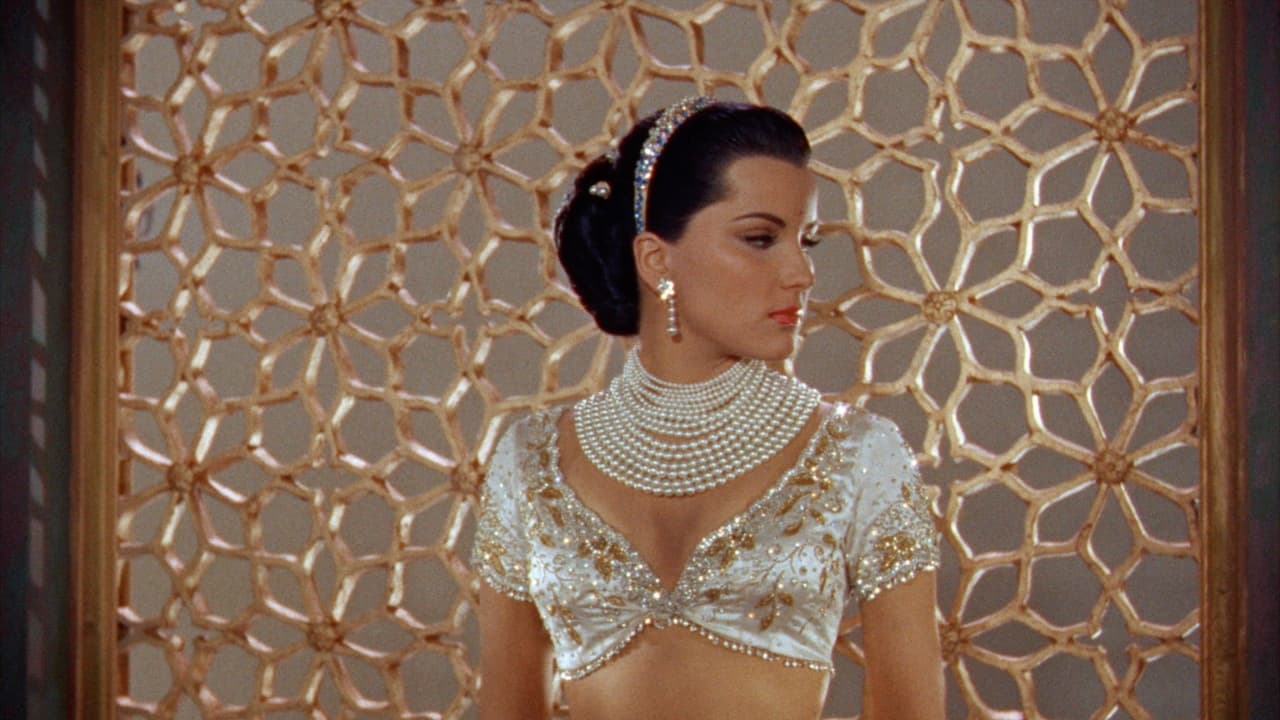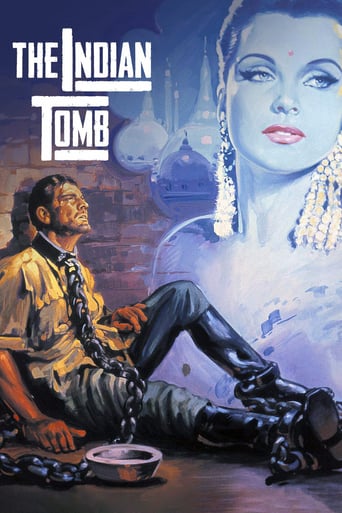

How sad is this?
... View MoreI saw this movie before reading any reviews, and I thought it was very funny. I was very surprised to see the overwhelmingly negative reviews this film received from critics.
... View MoreThis is one of the few movies I've ever seen where the whole audience broke into spontaneous, loud applause a third of the way in.
... View MoreThere is definitely an excellent idea hidden in the background of the film. Unfortunately, it's difficult to find it.
... View More"Das indische Grabmal" is a German 100-minute movie from almost 60 years ago and a sequel to "Der Tiger von Eschnapur". It was one of director Fritz Lang's last works and it is nowhere near as famous as his early silent film classics. Still, in terms of 1950 films, it's amount the most known Germany has to offer. If you see the characters in this film, they may not seem German to you, but do not be fooled by the heavy makeup. The actors all are, which you also see through the fact that their German is fluent and without accents. However, the film is not as fluent. I was already not impressed by Lang's first film from that duology and this one here is at least as forgettable. The story tries to be ambitious from start to finish, but it just never succeeds. The mediocre range from most of the actors, including the core actors, also does not help at all. It may be an acceptable film in terms of cinematography and the visual side, but in terms of the story, there is really nothing memorable to it. I also found it disappointing how they treated certain core aspects from the first film, as if they are totally irrelevant now. Sad to see Lang go out on a low note. Not recommended.
... View MorePlease see also my review of The Tiger of Eschnapur.The Indian Tomb was the second part of a pair of pictures directed by Fritz Lang, his first German productions since the 1930s, adapted from a screenplay he had himself worked on nearly thirty years earlier. The two of them should really be considered one whole work as much as were his two-part epics from the silent era, Dr Mabuse: Der Spieler (1922) and Die Nibelungen (1924). These earlier opuses were among the most prestigious works made, not only in Germany but anywhere in the world at the time. However this Indian diptych of the late-50s, a product of the drastically different post-war German film industry, looks like some cheap and cheerful Euro B-flick, at least at first glance.The Indian Tomb and its forerunner The Tiger of Eschnapur certainly bear many hallmarks of a trashy proto-exploitation feature. The Indian characters are played rather unconvincingly by Europeans in "brownface", the special effects are often laughable (stuffed tigers in part one, which are outdone by plastic cobras in part two), a bit of partial female nudity, and a fast-paced plot of action and romance with more than of a few plot holes, imagination-stretchers, and complete suspensions of logic – the most stupendous of which has to be the unexplained concept that lepers are actually zombies. To make matters worse, the two pictures were cut down into one movie by American International Pictures, Roger Corman's distributor, and for years this was all English-speaking audiences could see of them. Today however we are lucky enough to have fully-restored versions of both parts available to us, including a subtitled German version, which is far preferable to the atrocious English dub, assuming you can get over the illogic of Indians speaking to each other in German. Now at last we are able to rediscover and re-evaluate Fritz Lang's final masterpiece.On closer inspection, these two pictures are not quite so low in their values and appeal as one might think. For a start, the fact that Europeans play Indians is not really so different to westerners playing Arabs in Lawrence of Arabia. And there would be female nudity in Blow-up, and that is considered arty! The cast, while not exactly award-worthy, are uniformly decent, with the standout being Walter Reyer's eerily underplayed portrayal of the unbalanced Maharajah. There's a fabulous musical score by Gerhard Becker, and although admittedly the invented "Uncle Pat" song sounds more like a Gregorian chant than a Irish folk ballad, when Becker interpolates it into the main score on sweeping strings it makes a wonderful, aching love theme. The plot too is more than just your typical fight-a-minute no-brainer. While far from realistic its rip-roaring adventure has many strands to it, such as the political infighting of the fictional eastern province and the Maharajah's descent into jealousy-fuelled madness. It is of course aspects like this that would have been ripe for the chop when the pictures were re-edited in the US.And now let us turn to the contribution of Herr Lang himself. Although he spent most of his twenty years in Hollywood making cheap and sometimes nasty B-flicks, he never lost the flair and professionalism of his early German career, at which time he was rightly regarded as one of the most important talents at UFA studios. He was always at his best presenting adventure stories tinged with a slightly dark, paranoid streak which, while unfortunately being the subject of auterist psychobabble, mainly serves to heighten the sense of danger and excitement. As in The Tiger of Eschnapur the vast, angular sets are given prominence, with shots composed so that the walls seem to press in on all sides. There's often a passage or open door at the back of the room, suggesting that the heroes could be crept up upon from behind at any moment. Early on there's a shot where Walter and Irene are in their quarters, and a net curtain covers one corner of the frame. By cinematic convention this looks like a point-of-view shot, which gives this unnerving feeling that the couple are being watched. The carefully orchestrated action finale, in which all the various elements – the rebellion, Harald's escape, the flooding of the catacombs – reach a crescendo is reminiscent of the climactic scenes of Metropolis and Die Nibelungen. It is really such a good thing that Lang, the man who brought our dreams and our nightmares to the screen with such vibrancy, did not end his career in lower-end Hollywood productions. His Indian epic is a glorious and worthy tribute to his silent-era heyday.
... View MoreSeetha (Debra Paget) and Harold Berger (Paul Hubschmid) are rescued from the desert by a caravan and brought to a small village. However, the greedy owner of the house where they are lodged betrays the law of hospitality and reveals their location to Prince Ramigani (René Deltgen). The couple tries to escape but is hunted and captured by Ramigani and his men. Meanwhile Irene Rhode (Sabine Bethmann) and her husband Walter Rhode (Claus Holm) suspect that Maharaja Chandra (Walter Reyer) is not telling the truth about Harold's destiny. The conspirator Ramigani forces Seetha to accept to get married with Chandra to provoke the wrath of the priests and get the alliance of Prince Padhu (Jochen Brockmann) and his army. In the meantime, Harold succeeds in escaping from the dungeon and seeks out Seetha to save her. "Das Indische Grabmal" is the delightful conclusion of a romantic adventure in the exotic India. This family movie seems to be a matinée with wonderful moments, like for example, the spider building its web and protecting the lovers after the offering of Seetha to her god Shiva; or the sexy dance of Seetha; or the maze in the underground of the palace; or the dead bodies without gore. The colors are splendidly restored in the DVD released in Brazil by Continental in the beautiful locations and sets, and it is possible to see the strings controlling the snake while Seetha is dancing. My vote is eight.Title (Brazil): "Sepulcro Indiano" ("Indian Tomb")
... View MoreSecond part of Fritz Lang's bizarre epic about Indian mysticism shot for television and cut into two features by the studio (the other part being The Tiger of Eschnapur); it's a brilliantly executed pulpy and humorous masterpiece, with breathtaking color cinematography and elaborate set design which rivals the underworld city in Metropolis. Lang really celebrates the artifice of film, and his uncanny sense for mise-en scene proves his mastery of the craft. It's certainly a strange work and perhaps a bit hackneyed, but one should keep an open mind and sink in to the vivid images and spectacular naive tale of power and magic.
... View More